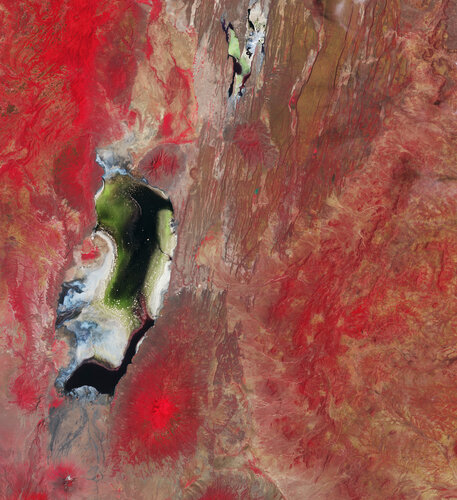The Copernicus Sentinel-2 mission captures the colourful waters of two salty lakes in East Africa: Lake Natron in northern Tanzania and Lake Magadi in southern Kenya.
Zoom in to explore this image at its full 10 m resolution or click on the circles to learn more.
Lake Natron, the large lake at the bottom of the image, is 56 km long. It is rather shallow, only reaching a depth of 3 m, although its depth varies during the year. Despite the lake being very salty in a region that suffers scorching temperatures, the lake basin is recognised as a Ramsar wetland of international importance. It is the only regular breeding area for lesser flamingos in East Africa. There can be as many as 2.5 million flamingos congregating on the lake, which also offers a habitat for thousands of other species of waterbird.
The smaller Lake Magadi, at the centre top, is located in a vast depression in an area of volcanic rock. No permanent river enters the lake, which is fed only by surface runoff when it rains. Like Natron, Magadi has a notably high salt content – in some places the salt is up to 40 m thick – and it’s one of the few places on Earth where the mineral trona forms naturally. Trona is used for glass manufacturing, fabric dyeing and paper production.
This image was acquired on 12 February 2023 during the short dry season, immediately before the main rainy season that begins in March. Owing to algae that thrive on the salt, both lakes are naturally red or pink, especially during the dry season when water evaporates and the salts become more concentrated. Here, however, the colours are because the image processing included Sentinel-2’s near-infrared channel, which helps to reveal different information than what is yielded in a natural colour image.
While heavy shades of red highlight vegetated areas and dominate this false-colour image, the seasonal flowering of algae in the lakes appears green. The bright white and blue areas along the shores depict a mixture of sand, salt and mud flats. Salt crusts, resulting from evaporation caused by high temperatures, can be spotted as white dots speckling the waters.
Sentinel-2 is a two-satellite mission to supply the coverage and data delivery needed for Europe’s Copernicus programme. The mission’s frequent revisits over the same area and high spatial resolution allow to measure changes in the conditions of inland water bodies – one of the mission’s main applications along with land cover, agriculture and forestry.



 Image:
The Copernicus Sentinel-2 mission captures the colourful waters of two salty lakes in East Africa: Lake Natron in northern Tanzania and Lake Magadi in southern Kenya.
Image:
The Copernicus Sentinel-2 mission captures the colourful waters of two salty lakes in East Africa: Lake Natron in northern Tanzania and Lake Magadi in southern Kenya.